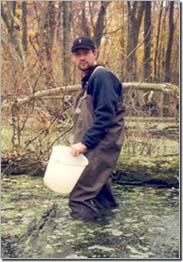Projects
Host-Parasite Coevolution

Variation in host life history patterns may be a result of a parasite adaptation, a host adaptation or a non-adaptive side effect of the interaction. Genetic heterogeneity of hosts and parasites fuels the coevolutionary arms race leading to an array of varied outcomes. In the coevolutionary interactions between participants, hosts respond to parasite selective pressures by evolving mechanisms for evading, counteracting, or minimizing the negative fitness effects of parasitism. We have suggested that a host may be able to modify the outcome of a parasitic infection either 1) by resisting infection via initiation of immune responses or 2) by varying other life-history parameters. The degree to which hosts exhibit these responses depends on numerous factors from the force of infection to the prevailing environmental conditions. The traditional view is that hosts prevent infection through genetically-based resistance to parasites. Resistance to infection is generally regarded as a costly undertaking that results in trade-offs with other life-history traits; however, empirical evidence for this view is lacking. One thrust of this laboratory is to assess the potential costs of resistance under varying biotic and abiotic conditions. Alternatively, hosts may alter infection outcomes by varying other (non-immunological) life-history characters, which may be less costly than resistance. Using the snail-trematode system as a model, we have been exploring the range of tactics utilized by molluscan hosts, including changes in reproductive output, survivorship, and growth. Overall, we hope to extend our view of parasite-induced host variation, address concepts of life history theory, and explore models that attempt to explain coevolutionary interactions between hosts and parasites.
Parasite Competition and the Evolution of Disease
Inter- and intra-specific competition between parasites within a host can have implications for disease intensity and parasite transmission. Kin selection theory predicts that the genetic relatedness of co-infecting parasites will determine whether they are more or less damaging to their host. Additionally, factors that influence the genetic composition of a parasite infection, such as host movement or resistance, can influence the evolution of disease in parasite populations. This laboratory uses a mixture of field, molecular, and life history measurements to better understand the impacts that parasite competition has on transmission and disease severity. We use laboratory and field studies to examine how the genetic relatedness of a parasite infection influences disease outcomes and observe changes in co-infections over time. Understanding the dynamics of competitive interactions throughout a parasite’s life cycle helps broaden our understanding of parasitic infection and disease.
Genetic Structure of Parasite Populations

Interactions between trematodes and their snail hosts play an important role in the development of the host and parasite genetic systems. The extent of genetic heterogeneity in local parasite populations has implications on the epidemiology of host disease. Blood flukes of the genus Schistosoma cause human schistosomiasis, a disease affecting more than 200 million patients worldwide. This parasite exhibits significant phenotypic differences within and among geographic populations, yet the degree of genetic variability in both the parasite and its host snails remains largely unknown. Our laboratory has been a leader in the study of natural diversity of these parasites. Heterogeneity of schistosome populations in nature is difficult to study due to the location of the adult worms within the human blood system and the small size of the larval stages associated with transfer between hosts. We have been able to circumvent these difficulties by using mtVNTR markers and single locus molecular probes (microsatellites) to quantify the degree of host and parasite genetic heterogeneity in natural populations and to determine how that variation changes on a spatial and temporal scale. We are assessing the genetic population structure of schistosome parasites from molluscan and human hosts in Brazilian villages utilizing molecular markers. In addition, both deterministic and simulation models are being developed to explore the role of genetic polymorphism in this host-parasite system.
Gene transfer between hosts and parasites
It is long been known that bacteria can swap genes between each other by a process known as “horizontal gene transfer”. Today, the evidence shows that animals and plants also have the ability to exchange genes. In fact, animal and plant parasites can act as vectors, transferring genes between hosts. The number of reports of parasite mediated horizontal gene transfer is growing, but some of these reports need to be validated using more rigorous methods. Sequence similarity and phylogenetic incongruence have been widely used to identify gene transfers. We have examined past studies to identify supported gene transfer events and are working to promote the use of genome sequencing, as well as ecological and geographical compatibility of “gene donors” and “gene recipients” in substantiating gene transfers. Identification of parasite-associated gene transfers improves our understanding of the intricacies of host-parasite interactions, shedding new light on the evolutionary “arms-race” between hosts and parasites.